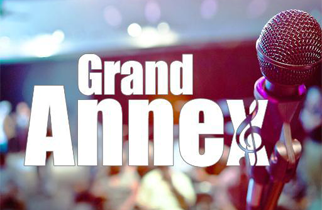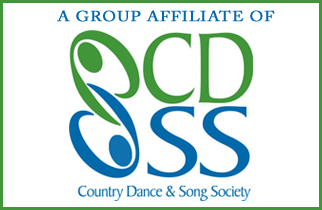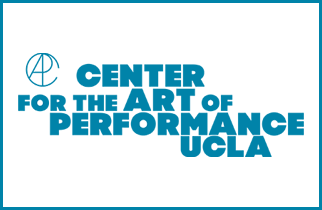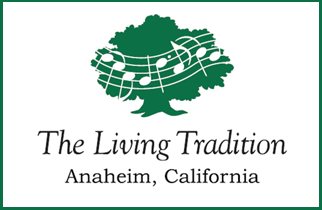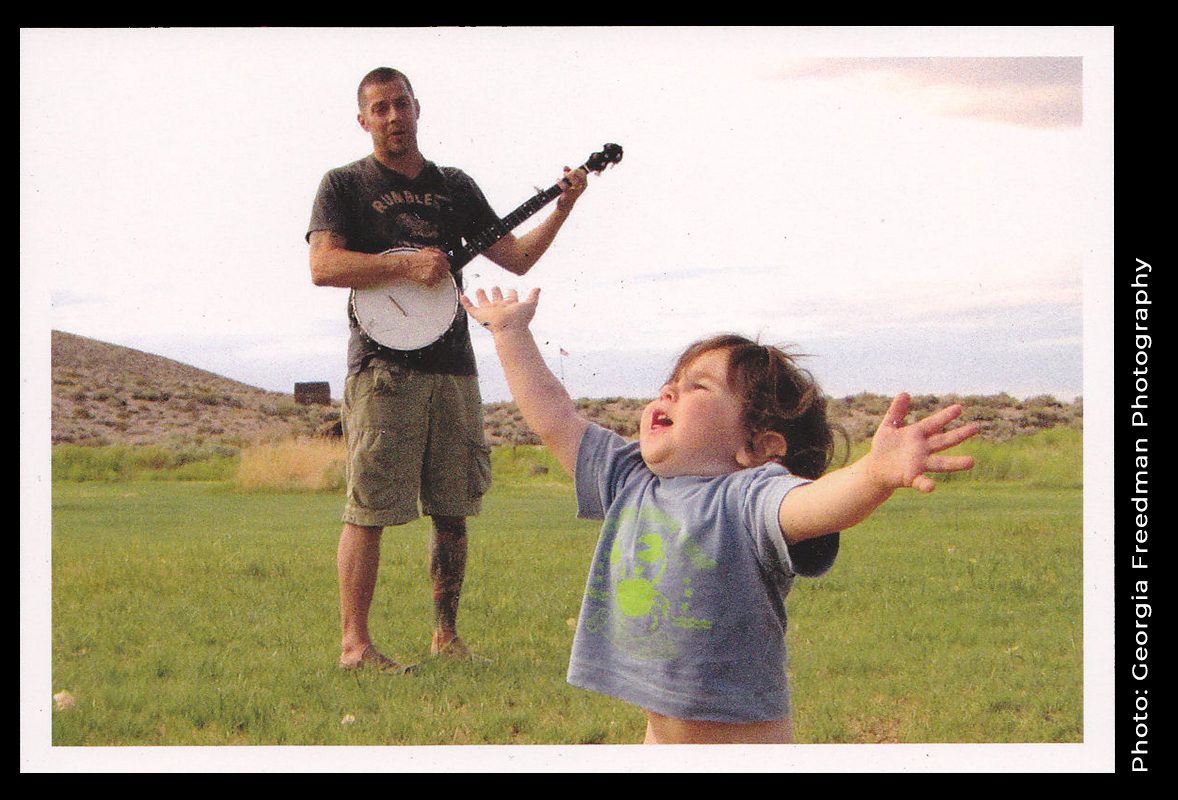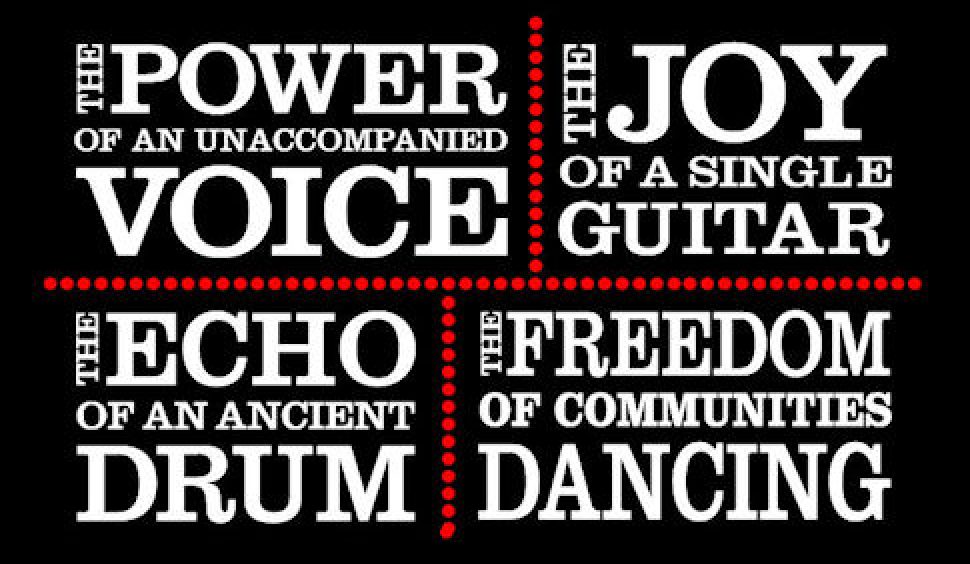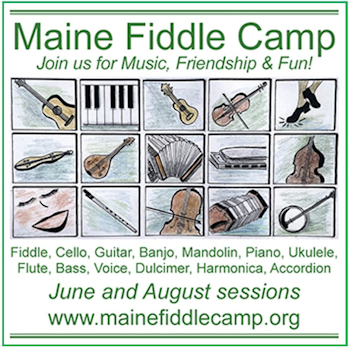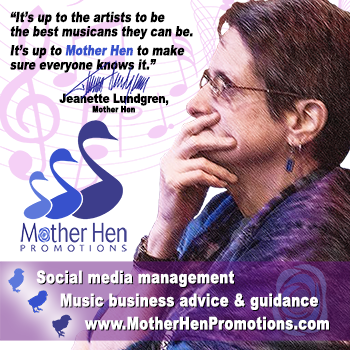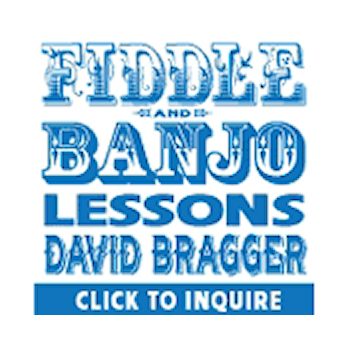HAVE UKE WILL TRAVEL!
HAVE UKE WILL TRAVEL!
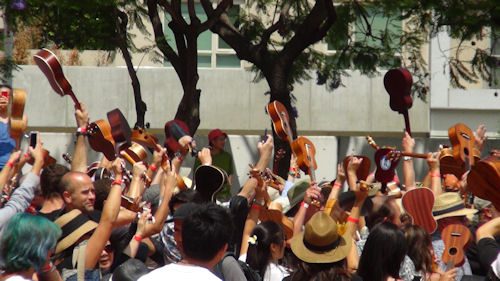
Over 1000 ukulele players turned out to attend workshops and try beat the world record for largest ensemble.
By nine a.m., under mercifully overcast skies, a steady stream of participants was filing into the front plaza of the Japanese-American Cultural Center in downtown LA. They all seemed to have a bounce in their step. From the balcony overlooking the plaza, I watched the crowd grow, a jocular mingling of darker and fairer-skinned persons from diverse age groups, some wearing neutral jeans, tee-shirts, and huaraches, others adding vibrancy with Hawaiian shirts and Aloha print sundresses. More than a few Japanese American gentlemen sported dapper straw fedoras in contrast to their Anglo boomer counterparts sporting gray-haired ponytails. I noticed mothers nudging their pre-teenage children forward towards the registration tables. What did the members of this conglomeration have in common? They were all clutching ‘ukuleles.
Over a thousand players had registered for the first annual LA ‘ukulele Expo’ by 11:00am on June 28, 2014. It was scheduled to kick off with a mass performance arranged to beat the Guinness Book of World Records entry for the largest ‘ukulele ensemble in the world, an honor previously held by a gathering of over 2,000 players in Yokohama, Japan. Volunteers were still assigning new arrivals to various numbered groups and a jovial, expectant hum emanated from the plaza, now bathed in scorching sun. On the outdoor stage, the Expo organizers—multi-instrumentalist/composer/producer Daniel Ho and JACCC director Leslie Ito—got the crowd ready for the challenge to Yokohama. Ho taught his original song “Pineapple Mango” using giant posters of ‘ukulele tablature. Even beginners absorbed the chords and after a few practice rounds, the official rendition was performed several times.
Well, spirits soared if not numbers. A backup on the 5 freeway was blamed for the turnout that significantly trailed behind Yokohama’s record. Staying upbeat, Ho and Ito previewed the Expo workshops for the day: Uncle Lincoln Kaio teaching beginners; Steve Espaniola demonstrating Hawaiian strumming techniques; Abe Lagrimas and Sarah Maisel introducing intermediate players to jazz and blues on the uke; and Daniel Ho delving into melody making, harmony, and improvisation. Rounding out the program was a screening of a documentary about ‘ukulele superstar Jake Shimabukuro and a late-afternoon concert featuring Ho, Espaniola, Lagrimas, and Maisel. At 11:30 a.m. the crowd scattered in different directions to workshops rooms in the JACCC to soak up uke wisdom, but not before Daniel Ho directed attendees to hold their ukes up high for a group photo.
That’s a lot of enthusiasm for a little four-stringed instrument that for a long time was not considered a medium for “serious” musical pursuits. I did some checking on the origins of the uke. The ‘Ukulele: A History by King and Tranquada, published this year by University of Hawai’i Press, dispels myths about the instrument and adds some surprising dimensions to its story. Come with me to the small island just west of Morocco where the ‘ukulele’s direct ancestor was born.
The Uke Before Hawaii
The island of Madeira, under the Portuguese flag since the early fifteenth century, has a rich tradition of folk music and artisanal cabinet-making, both of which figure in our story. In the 1800s Madeiran musical craftsmen developed a small four-stringed folk instrument they called the machete (spelled machette in some accounts). It gained wide popularity. Travel writers noted its presence in community celebrations; one American tourist described it as a dwarf guitar with a tone similar to that of a violin. In the latter part of the century, Madeirans took their machetes along on the trip to Hawaii where they worked as laborers for agricultural enterprises or as independent cabinet makers and tinsmiths practicing their trades in the growing internationalized community of Honolulu. A single ship in 1879 documented nearly a thousand Madeiran workers contracted for agricultural work.
Soon Madeiran arrivals strolled the streets of Honolulu playing their machetes and instantly enchanted both native Hawaiians and non-Hawaiian residents with their music-making. Hawaiians in particular were attracted not only by the sound of the stringed instrument but by its easy portability. Demand for the Portuguese machete grew so quickly that by 1885 Madeiran cabinet makers Augusto Dias and Manuel Nuñes were advertising their services as instrument makers in a Honolulu newspaper. The machete cost significantly less than a guitar, which was already an established instrument among Hawaiians.
The Name
The first name Hawaiians gave to the machete was pila li’ili’i, meaning little fiddle. Some English and American residents and tourists in Honolulu for a time referred to it as the taro patch fiddle, a nod to the Hawaiian staple crop, taro (kalo in Hawaiian) grown in shallow muddy ponds similar to rice paddies. But by the late 1880s the name ‘ukulele had taken hold. There is more than one explanation for its origin. Most frequently we are told that the Hawaiians likened the rapid movement of the hands on the strings to a jumping or fast-moving (lele) flea (uku). Researchers King and Tranquada suggest a possible derivation from Hawaiian words uke meaning to strike wood and lele meaning to move quickly. Regarding pronunciation, the initial “u” sound for the word in Hawaiian is oo as in too. This did not stop Americans and Europeans from pronouncing it “yoo-kulele” and still doesn’t. Also, Hawaiians have always pronounced the initial “u” of ‘ukulele with a glottal stop, which is used before a number of initial vowels in their language. More recent print references to the ‘ukulele have reflected this practice by using the diacritical apostrophe preceding the “u.”
By the 1890s, the instrument widely known as the ‘ukulele was becoming a regular feature of Hawaiian folk performance and was described in tourist literature as the national instrument of the Hawaiian Islands. Back in Madeira, by the way, the machete took on a new Portuguese name early in the twentieth century—braguinha. So, when you read or hear that the ‘ukulele was originally the Portuguese braguinha, you’ll have the inside scoop about its original name.
The ‘ukulele took became increasingly Hawaiianized as instrument makers began using local hardwoods such as highly prized koa in construction instead of importing spruce and pine from Europe as they did for furniture. The patronage of Hawaiian monarchs further enhanced the instrument’s status. A photo of King David Kalakaua entertaining Robert Louis Stevenson shows the King’s “singing boys” playing ‘ukuleles for the guests. The King’s sister and heir, Queen Liliuokalani, a prolific composer of mele (songs) in Hawaiian and English, accompanied herself on the ‘ukulele.
Mainlanders Take to the Uke
The annexation of Hawai’i by the United States at the end of the century ushered in a new spurt in tourism from the mainland. The iconic image of the hula dancer strumming the ‘ukulele tantalized the imaginations of mainlanders. A repertoire of songs in Hawaiian, English, and a combination of the two enhanced the popularity of the uke as an accompaniment for the vocalist. By 1914 the Sears Roebuck catalogue was featuring ‘ukuleles crafted in mahogany. In the following year, a strong Hawaiian cultural presence at the Panama Pacific International Exposition in San Francisco ignited public interest as never before. Writer Laura Ingalls Wilder described the performances there by the Hawaiian Quintet under the gifted singer/composer/instrumentalist Henry Kailimai. The San Francisco event so impacted American music industry entrepreneurs that Hawaiian ‘ukulele production increased from about 600 per month in 1915 to 1600 per month a year later.
The national craze for Hawaiian music and the ‘ukulele in particular tied in to the sheet music and recording industries. Unfortunately, this did not necessarily always the musical repertoire. While the ‘ukulele accompanied some truly beautiful hapa haole (half-foreign) songs, mainland composers with less sensitivity cranked out fare such as fare such as “Oh! How She Could Yacki Hacki Wicki Wacki Woo.” Such trivializations of Hawaiian language and culture contributed in some measure tainted the ‘ukulele’s identity as a bona fide instrument.

Daniel Ho teaches the crowd at the first L.A. Ukulele Expo his composition Pineapple Mango.
Fast-Forward to 2014
Leaving for another column the uke’s role in the jazz age and beyond, let’s consider the breadth of genres that virtuoso Jake Shimabukuro now brings to worldwide audiences in concert settings. On his ‘ukulele, he has performed everything from meles by Queen Liliuokalani to the music of Bach, Ellington, and John Lennon. He is not alone in taking the ‘ukulele in exciting, creative directions.
At the Uke Expo, Hawaiian-born Abe Lagrimas told me he came to the uke in the midst of jazz studies as a percussion student at Berklee in Boston. Homesickness played a role in bonding with the instrument. “I really picked up the ‘ukulele as a way to bring Hawaii back to me…so I started learning songs by Peter Moon, the Makaha Sons, Brother Iz…But because of what I was studying, I made the connection with jazz and started learning jazz standards. I realized, yeah, I can do this.”
Emotions also played a strong part in bringing Sarah Maisel to the uke after she relocated from North Carolina to Southern California eight years ago. Homesick and depressed, she found a tonic in the “Hawaiian Night” that a San Diego pizza parlor held Wednesday evenings, complete with hula dancing and ‘ukulele music. “I walked in and it was completely life-changing,” she shared. “Everyone was so happy, it was a joyful place and I instantly wanted to be a part of it. Luckily the gentleman who ran that club was going to be teaching group ‘ukulele lessons at the local community college. That’s how I started.” Despite her background in classical violin, Maisel took up the uke with the devotion of a pro and has gained renown at festivals for her jazz and blues arrangements as well as her spirited vocals. *The title of this article is inspired by the title of her first CD, Have Uke Will Travel.
Daniel Ho started playing uke in his native Hawai’i at age seven. Noting the uke’s rise in popularity over the past decade, the L.A.-based multi-instrumentalist, composer, and Expo co-organizer connects it with the economic downturn. “It’s a cheap instrument. You can spend $100 and get a great uke,” he said. “It’s small, it’s portable, it’s fun, it’s happy. I love it for all those reasons.”
Furthermore, as a Hawaiian instrument, ‘ukulele technique is easier to learn than slack key guitar with its multiple tunings. These practical dimensions make the uke particularly suited to music education programs that typically have slim budgets. Along with composing, performing, and bringing the uke into the world music arena, Ho has designed a curriculum in collaboration with Steve Sano of Stanford University to teach ‘ukulele to groups of eight to ten year olds. It is being piloted in the Torrance Unified School District.
The little four-stringed instrument that traveled from Madeira to Hawai’i and, over a century later, enthralls players from L.A. to Yokohama, continues to inspire creativity. “It’s as challenging as you make it,” said Daniel Ho, who is planning on a 2015 L.A. ‘Ukulele Expo. “A violin has four strings, and, my gosh, they do concertos. You can do the same thing on the uke.”
For introductory uke immersion, I recommend:
Legends of the ‘ukulele: Hawaiian Masters. Cord International, 2003.
Gently Weeps: Jake Shimabukuro. Hitchhike Records, 2006.
‘Ukuleles in Paradise: Herb Ohta, Jr. and Daniel Ho. Daniel Ho Creations, 2005.
Abe Lagrimas, Jr.: Rhythm and Uke. Passout Records, 2014.
Have Uke Will Travel: Sarah Maisel. Rolltop Music, 2012.
Interested in taking up the uke in the L.A. area? Beginner and intermediate ‘ukulele classes are available on Sunday afternoons at U-Space located in the JACCC. Fall classes begin September 7. For more information, e-mail UspaceLA@gmail.com.
Mixed-level instruction, Hawaiian-style, with ongoing open-entry is given by Lincoln Kaio Wednesday and Thursday evenings and Friday mornings. Contact Uncle Lincoln at 310-500-5202.
Audrey Coleman is a writer, educator, and ethnomusicologist who explores traditional and world music in Southern California and beyond.


